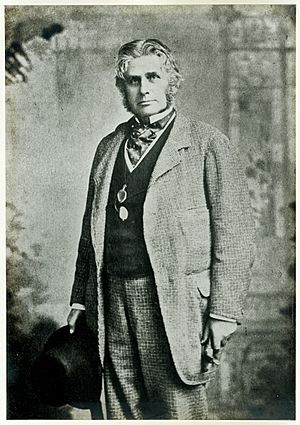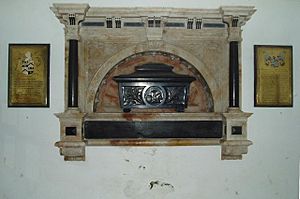Augustus Pitt Rivers facts for kids
Quick facts for kids
Augustus Pitt Rivers
FRS FSA FRAI
|
|
|---|---|
 |
|
| Born |
Augustus Henry Lane Fox
14 April 1827 |
| Died | 4 May 1900 (aged 73) Rushmore Estate, Wiltshire, UK
|
| Nationality | English |
| Scientific career | |
| Fields | Ethnology, archaeology |
| Influenced | Mortimer Wheeler |
| Military career | |
| Allegiance | |
| Service/ |
|
| Years of service | 1845–1882 |
| Rank | Lieutenant General |
| Battles/wars | Crimean War |
Lieutenant General Augustus Henry Lane Fox Pitt Rivers (1827–1900) was an English officer in the British Army. He was also a very important ethnologist (someone who studies different cultures) and archaeologist (someone who studies human history by digging up old things).
He is famous for creating new ways to dig up and study ancient sites. He also changed how museums displayed collections of old objects and cultural items. His huge collection of about 22,000 objects started the Pitt Rivers Museum at the University of Oxford. Another collection of English archaeology from the area around Stonehenge is now at The Salisbury Museum in Wiltshire.
For most of his life, he used the name Lane Fox. But in 1880, he inherited a large estate from a cousin, Lord Rivers. As part of the inheritance, he had to change his name to Pitt Rivers.
Contents
Early Life and Family History
Augustus Henry Lane-Fox was born in 1827 in Bramham cum Oglethorpe, a village near Wetherby in Yorkshire. His father was William Lane-Fox, and his mother was Lady Caroline Douglas.
In 1880, Augustus inherited a large amount of land and money from his cousin, Horace Pitt-Rivers. This inheritance changed his life. To receive it, he had to take on the surname Pitt-Rivers.
In 1853, Augustus (still known as Fox at the time) married Alice Margaret Stanley. Her father was a politician, and her mother, Henrietta Stanley, worked to improve women's education.
Augustus Pitt Rivers' Children
Augustus and Alice had nine children who grew up to be adults. All of them were born before Augustus changed his last name to Pitt-Rivers in 1880. Their names were:
- Alexander Edward Lane Fox-Pitt-Rivers
- St. George Lane Fox-Pitt, who became an electrical engineer
- William Augustus Lane Fox-Pitt
- Ursula Katharine Lane Fox-Pitt
- Lionel Charles Lane Fox-Pitt
- Alice Augusta Laurentia Lane Fox-Pitt
- Agnes Geraldine Fox-Pitt
- Douglas Henry Lane Fox-Pitt
- Arthur Algernon Lane Fox-Pitt
Military Career and Service
Augustus Lane Fox had a long and successful career in the military. He studied at the Royal Military College, Sandhurst, when he was 14 years old. In 1845, he joined the Grenadier Guards.
During his 32 years in the army, he mostly worked as a staff officer. He only saw major fighting once, at the Battle of Alma in 1854 during the Crimean War. After this battle, he returned to England because he was not fit for active service.
In 1851, he helped test new army muskets. He also taught soldiers how to use the new Minié rifle. He was a key person in setting up the Hythe school of Musketry in Kent. He even wrote a new instruction manual for musketry.
He was promoted several times, becoming a Captain in 1850 and a Lieutenant-Colonel during the Crimean War. He retired from the army in 1882 with the honorary rank of Lieutenant General.
Archaeological Discoveries
Pitt Rivers became interested in archaeology and ethnology in the 1850s. He started collecting items that showed how human inventions, like weapons and tools, changed over time. His collection became very famous. In 1885, he gave it to the University of Oxford. This collection became the start of the Pitt Rivers Museum.
In 1867, Pitt Rivers visited an archaeological dig in Yorkshire. He learned about excavation from Canon William Greenwell, a well-known archaeologist. Greenwell taught him that archaeology was a serious study, not just looking for treasures. This idea greatly influenced Pitt Rivers.
By the time he retired from the army, he had collected tens of thousands of items from all over the world. He was inspired by the ideas of Charles Darwin about evolution. So, he arranged his collections to show how human tools and cultures developed over long periods. This way of organizing museum displays was a new and exciting idea at the time.
The Pitt Rivers Museum in Oxford now holds over half a million items. These include archaeological finds, cultural artifacts, photos, and old documents from around the world. The museum was founded in 1884 when the university accepted his gift of more than 20,000 items. Today, it is known as one of the world's most important ethnological museums.
Pitt Rivers also had a collection of archaeological items from Wessex, an area near Stonehenge. This collection is now at The Salisbury Museum. The Wessex Gallery there celebrates Pitt Rivers and other early archaeologists who studied the ancient history of Wiltshire.
The land Pitt Rivers inherited in 1880 had many ancient Roman and Saxon sites. He spent 17 years digging at these sites until he died. His methods were very careful and organized for his time. He is often called the first scientific archaeologist in Britain.
His most important new idea was to collect and record all artifacts, not just the beautiful or rare ones. He believed that everyday objects were key to understanding the past. This was a big change from earlier archaeology, which was often just like treasure hunting. His work inspired other archaeologists, like Mortimer Wheeler.
Pitt Rivers also created the Larmer Tree Gardens, a public park, on his estate in Wiltshire.
In 1882, a law called the Ancient Monuments Protection Act 1882 was passed. Pitt Rivers became the first Inspector of Ancient Monuments. His job was to find and protect archaeological sites from being destroyed. He worked very hard, but the law gave him little power over landowners.
He advised that Kit's Coty House and Little Kit's Coty House in Kent be among the first ancient British sites protected by the state. Fences were put up around the stones to stop vandalism.
Advocating for Cremation
Pitt Rivers believed in cremation (burning a body after death). Many people at the time thought this was wrong. However, Pitt Rivers supported it as a practical way to deal with bodies. After he died in 1900, he was cremated.
Images for kids



